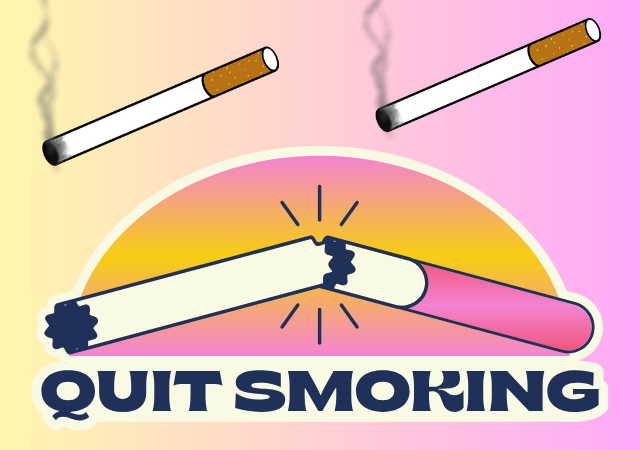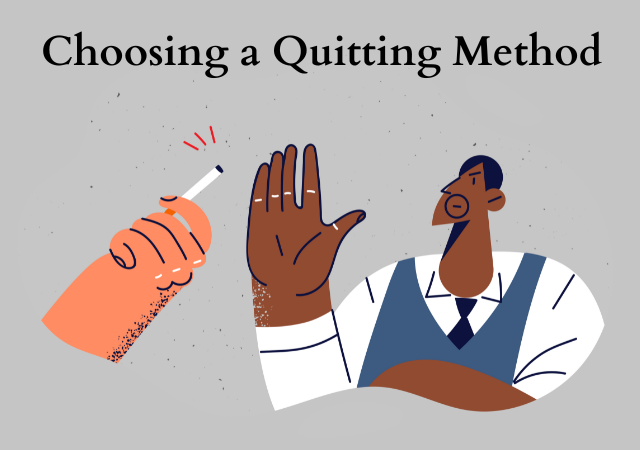A Comprehensive Guide on How to Quit Smoking
Introduction
Smoking is a habit that millions of people around the world struggle to break free from. The allure of nicotine and the comforting ritual of lighting a cigarette can make quitting a formidable challenge. However, the health risks associated with smoking are well-documented, and the decision to quit is one of the most significant steps you can take toward a healthier, happier life.
This comprehensive guide is your roadmap to a smoke-free future. In the following pages, we will explore the multifaceted nature of smoking addiction, from the physical dependence on nicotine to the psychological and emotional aspects that keep individuals hooked. We will provide practical advice on how to prepare for your quit date, choose the right quitting method, and create a personalized quit plan.
We’ll discuss strategies for managing withdrawal symptoms and staying strong in the face of cravings. Additionally, we’ll address the common challenges of relapse and offer insights on how to bounce back when setbacks occur. With professional guidance and support, you can overcome the grip of tobacco and embark on a journey towards a healthier, smoke-free life.
Understanding Smoking Addiction

Before embarking on your journey to quit smoking, it’s essential to understand the nature of your addiction. Smoking is not just a habit; it’s a complex web of physical and psychological dependencies.
1. The Role of Nicotine
Nicotine is the primary addictive substance found in cigarettes. When you inhale nicotine, it reaches your brain within seconds, causing the release of dopamine, a neurotransmitter associated with pleasure and reward. This process creates a strong positive reinforcement, making it challenging to quit. As you reduce nicotine intake, withdrawal symptoms may occur, including irritability, cravings, and anxiety.
2. Psychological and Behavioral Aspects
Smoking often becomes intertwined with daily routines and activities. Whether it’s a cigarette with your morning coffee or a smoke break with coworkers, these rituals can become triggers for smoking. Recognizing these associations is a crucial step in breaking the habit.
Preparing to Quit

1. Setting a Quit Date
One of the first steps in your journey to quit smoking is setting a quit date. Choose a specific day within the next few weeks as your target to stop smoking. This gives you a clear goal and allows time to prepare mentally and emotionally.
2. Informing Friends and Family
Let your close friends and family know about your decision to quit smoking. Their support can be invaluable, and it keeps you accountable. Sharing your goals with loved ones creates a network of encouragement to help you through the challenging times.
3. Seeking Support
Don’t hesitate to seek professional support. Your healthcare provider can offer valuable guidance, recommend smoking cessation programs, or prescribe medications to help manage withdrawal symptoms. Additionally, various support groups and online communities provide a platform for sharing experiences and receiving support from others facing the same challenges.
Choosing a Quitting Method

There is no one-size-fits-all approach to quitting smoking. Different methods work for different people, so it’s essential to choose the one that best aligns with your needs and preferences.
1. Cold Turkey
Some individuals opt for the “cold turkey” method, which involves quitting abruptly, without the aid of medications or nicotine replacement therapies. While this approach can be effective for some, it may be more challenging due to the sudden cessation of nicotine intake.
2. Nicotine Replacement Therapy (NRT)
NRT offers several products designed to gradually reduce nicotine intake, such as nicotine patches, gum, lozenges, and nasal sprays. NRT can help manage withdrawal symptoms while you work to break the psychological habit of smoking.
3. Prescription Medications
There are prescription medications available that can aid in smoking cessation. Options like bupropion (Zyban) and varenicline (Chantix) can help reduce cravings and withdrawal symptoms. Consult your healthcare provider to determine if these medications are suitable for you.
4. Alternative Therapies
Alternative therapies, including acupuncture, hypnotherapy, and mindfulness, have helped some individuals quit smoking. These approaches focus on addressing the psychological and behavioral aspects of addiction. While their effectiveness varies, they may be worth considering, especially in combination with other methods.
Creating a Quit Plan

1. Setting Realistic Goals
When creating your quit plan, set achievable goals. Rather than aiming for immediate perfection, focus on gradual reduction and progress. Celebrate small victories along the way to reinforce your commitment.
2. Identifying Triggers and Developing Coping Strategies
Recognize the situations and emotions that trigger your cravings. Whether it’s stress, boredom, or social situations, identify these triggers and develop coping strategies. For instance, you could replace smoking with a healthier alternative, like chewing sugar-free gum or taking a walk.
3. Establishing a Support System
Lean on your support network. Share your goals with friends and family, and ask for their understanding and encouragement. Consider attending support group meetings or connecting with online communities for additional support and motivation.
Dealing with Withdrawal Symptoms

Withdrawal symptoms are a natural part of the quitting process. Recognizing and managing these symptoms is crucial to your success.
1. Common Withdrawal Symptoms
Withdrawal symptoms vary from person to person but often include:
- Nicotine cravings: These can be intense but typically last for a short time.
- Irritability: You may feel more easily agitated during the early stages of quitting.
- Difficulty concentrating: Nicotine withdrawal can affect your ability to focus.
- Increased appetite: It’s common to experience a temporary increase in appetite after quitting.
2. Coping Strategies for Managing Cravings
- Distract yourself: Engage in activities that keep your mind and hands busy, like puzzles or knitting.
- Deep breathing and relaxation: Practice deep breathing exercises to reduce stress and anxiety.
- Physical activity: Regular exercise can help reduce cravings and improve mood.
- Nicotine replacement therapy (if chosen): Use NRT products as directed to alleviate cravings.
3. Staying Active and Occupied
Staying active and finding new hobbies can help divert your focus from smoking. Exercise not only reduces stress but also releases endorphins, which can improve your mood. Engaging in activities you enjoy can be a positive replacement for the time spent smoking.
Staying Smoke-Free

Breaking free from smoking is a significant achievement, but staying smoke-free requires ongoing effort. Here are some strategies to help you maintain your progress:
1. The Importance of Lifestyle Changes
Make positive changes in your daily life to reduce the risk of relapse. This can include:
- Avoiding situations that trigger cravings: If certain places or people are associated with smoking, try to limit your exposure.
- Building a smoke-free environment: Remove cigarettes, lighters, and ashtrays from your home and car.
- Healthy eating: Maintain a balanced diet to help manage weight gain that can occur after quitting.
- Regular exercise: Stay active to keep your mind and body healthy.
2. Avoiding Triggers and High-Risk Situations
Identify situations or emotions that may trigger cravings and plan ahead. Find alternative ways to cope with stress and avoid high-risk situations where smoking is more tempting.
3. Rewarding Yourself for Milestones
Celebrate your milestones, whether it’s one day, one week, or one month smoke-free. Treat yourself with something you enjoy, like a movie night, a new book, or a special meal. These rewards reinforce your success and motivate you to continue.
Coping with Relapses
Relapses are a common part of the quitting process. Rather than viewing them as failures, use them as opportunities for learning and growth.
1. Understanding Relapse as Part of the Process
It’s important to recognize that relapse doesn’t mean you’re doomed to be a smoker forever. Many people experience multiple relapses before achieving long-term success. Relapse is a chance to understand what triggered your return to smoking and plan more effectively for the future.
2. Identifying the Causes of Relapse
Take time to identify the factors that led to your relapse. Were you in a high-stress situation? Did you encounter an old smoking buddy? Once you understand these triggers, you can work on strategies to prevent them from causing future relapses.
3. Getting Back on Track
After a relapse, don’t be discouraged. Instead, refocus on your goal of quitting. Review your quit plan, seek additional support, and learn from your experiences. Most importantly, be patient and forgiving with yourself as you continue your journey toward a smoke-free life.
Long-Term Benefits of Quitting

Quitting smoking has numerous long-term benefits that extend beyond improved health:
1. Improved Health and Well-Being
Quitting smoking dramatically reduces your risk of serious health conditions, such as lung cancer, heart disease, and respiratory issues. You’ll notice positive changes in your health within days of quitting, and these improvements will continue for years.
2. Saving Money
Smoking is an expensive habit. Calculate how much money you’ll save by quitting, and consider how you could better use those funds to enhance your life.
3. Setting a Positive Example
Quitting smoking not only benefits your own health but also sets a positive example for those around you, especially children and younger family members. You become a role model for a healthier, smoke-free lifestyle.
Getting Professional Help

If you find quitting smoking particularly challenging, don’t hesitate to seek professional help.
1. The Role of Healthcare Providers
Your healthcare provider can be a valuable resource on your quitting journey. They can offer guidance, prescribe smoking cessation medications, and provide medical support to manage withdrawal symptoms.
2. Smoking Cessation Programs
Smoking cessation programs, often available at local health clinics or online, offer structured support and guidance from trained professionals. These programs can significantly improve your chances of success.
3. Online and Phone Support
In today’s digital age, a wealth of online and phone resources are available to support your journey. From apps and websites to hotlines and chat services, you can access information, motivation, and encouragement with just a few clicks.
Conclusion
Quitting smoking is a transformative journey that begins with a single step but offers a lifetime of rewards. It’s a process that involves understanding the nature of your addiction, setting goals, choosing the right quitting method, creating a personalized quit plan, and developing strategies to cope with withdrawal symptoms and cravings. While relapses may occur, they are learning opportunities that can ultimately lead to success.
The long-term benefits of quitting smoking are substantial, not only in terms of health but also in terms of finances and setting a positive example for those around you. Remember that professional help is readily available to support your journey, and you’re never alone in your quest for a smoke-free life.
Your decision to quit smoking is a powerful one, and with determination, support, and the strategies outlined in this comprehensive guide, you can take control of your life, overcome the grip of tobacco, and embrace a healthier, smoke-free future.

My name is Rohit Vagh and I’m a content writer specializing in fashion and lifestyle. I have three years of experience in this field and have written various articles. My writing style is creative and engaging, and I strive to create content that resonates with my readers. I have a deep passion for fashion and am constantly researching the latest trends and styles to make sure my readers are up to date. I’m excited to continue my career in blogging, and I’m always looking for new opportunities in the fashion and lifestyle space.





